Here are some in room therapy treatment suggestions from our Keystone Resources:
● “Boxing” while supine in bed to work on trunk rotation, rolling side to side for bed mobility, UE strength and activity tolerance; add weights if appropriate
● “I Spy” game for word finding/verbal reasoning goals
● Bird identification out the window. Laminate photos of birds/scavenger hunt looking out window
● Cleaning the bathroom mirror
● Decorating or making a calendar for orientation
● Decorating the room
● Drawing, window painting/drawing
● Fall recovery
● Folding laundry
● Game cards and play this while standing to add in cognition component
● Have a therapist in the hallway and have some residents in the doorway and do some deep breathing and gentle exercise! Maybe have some questions to help facilitate conversation.
● Have some pictures ready for them; have them pick a picture from the pile and have them describe it to you!
● Have them tell us a hobby and modify it for them! We are super creative!
● If they have flowers in their room, trim them and replace the water. This can be done sitting or standing. If they are higher level, have them sweep up the fallen leaves and petals.
● Instructing patients in correct hand-washing techniques
● Introduce HRV training to help relieve anxiety during this time
● Item retrieval/transport
● Making the bed
● Making a collage with family pictures
● Making a cool Easter egg balloon with yarn to hang in their room
● Making cards for their loved ones
● Organize closet by colors/season of clothes
● Painting on paper
● Place patient’s clothes around the room at various levels, have them walk around and gather items, make decisions on whether to use reacher or not, manage reacher and RW, energy conservation education regarding rest breaks, etc.
● Plant something in a flower pot to put in the window sill for them to watch grow
● Postural exercises, high/low reaching

● Put laundry on hangers and hang in closet (gross/fine motor and reaching)
● Scavenger hunt in room (list of objects to find)
● Small space functional mobility
● Talk about their life while they are rocking their wheelchair back and forth 🙂. They need to feel calm.
● Teaching them how to use the phone, FaceTime, and trying with a loved one … which brings happy tears, messenger on FB has a video chat as well, so setting them up to keep in touch with loved ones. Also, setting up a free music app on their phone, or a simple game like solitaire.
● Wall pushups working on posture
● Washing windows
● Wheelchair mobility “obstacle course” having to navigate around actual items and furniture in room
● Wheelchair pushups (5xSTS test)
Sequencing for sit to stand (brakes on, scoot up to edge of seat, back, hands in arm rest, fwd trunk nose over toes, 1, 2, 3, push up thru arms and LEs!). Get picky; perfect practice is the only way to instill good habits and break bad habits.
Sequencing for stand pivot transfers with assistive device
Standing balance (Romberg test), standing scalp retracts for stability, steps fwd, lateral, retro
Berg/Tinetti/TUG tests can be done in patient’s room and some aspects of them if anything can be worked on like 360-degree turns in place or picking object up from floor, etc.
● Writing letters/cards/postcards to loved ones
● Use AAC device to give instructions on how to set up/decorate the room; use patients’ phones or tablets for higher-level problem solving (e.g., sequencing steps to write a message on a niece’s Facebook timeline); use their phones/tablets to teach them to set up external memory aids (ex- add doctors’ numbers to contact list, set daily alarms for times they need to take meds); help them set up a grocery delivery acct for when they discharge home; use dysarthria (or aphasia or voice!) techniques during functional phone calls (talk to family, pay bills via phone, etc.); use objects in room for receptive language tasks (“Point to the razor THEN pick up the comb”).
